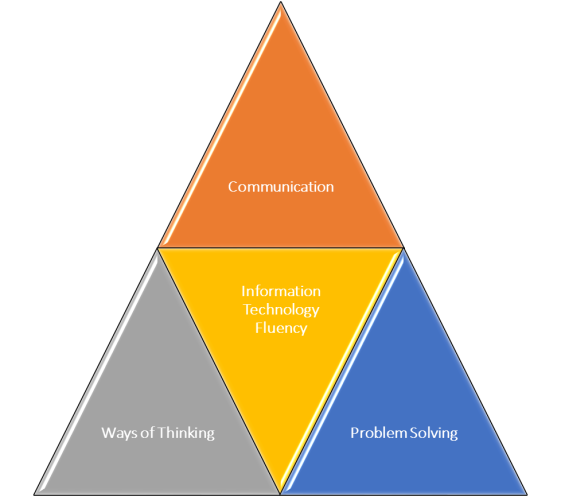When talking to instructors about what information literacy is, I’m not the biggest fan of referring to its commonly accepted definition: “Information literacy is the ability to recognize when information is needed and have the ability to locate, evaluate, and use effectively the needed information.”
Why? Because in order to embrace it, support it, and implement it in their courses, instructors need a description that more precisely breaks down the skill sets involved in information literacy so that they can determine how those skills best fit within the context of their courses. That’s where the instructional design skill of task analysis comes in (which also requires overcoming one’s expert blindspot).
What specific skill sets are needed for one to become information literate? I have identified four specific skills that help define the practice of information literacy, and I’ve decided to call them the “4 facets of information literacy” (see figure below). They are: 1) information technology fluency, 2) ways of thinking, 3) problem solving, and 4) communication.
Information Technology Fluency
I see information technology fluency as forming the basic core of information literacy, and encompassing such skills as information organization, database searching (e.g., keyword v. subject), web navigation, digital citizenship, and computer literacy. When students are fluent in these skills, the chance of cognitive overload is reduced when being introduced to the other facets of information literacy.
While there is a tendency for librarians to focus heavily on information technology fluency skills in beginning IL instruction (which is important), another approach would be for librarians to partner with technology instructors to ensure that the skills are fully addressed in the types of required technology-focused courses that can be found in both K-12 and in higher education.
Ways of Thinking
Librarians generally teach ways of thinking about information in the context of evaluating information. However, within a course, these skills are also being addressed anytime a teacher focuses on critical thinking, critical literacy, and/or disciplinary literacy. This is why co-teaching and collaboration between librarians and teachers is so very important.
In terms of teaching ways of thinking about information, librarians should keep in mind that students’ beliefs about information and about knowledge are developmental in nature.
Problem Solving
Solving problems with information puts ways of thinking into practice. This facet of information literacy fits neatly into inquiry-based, problem-based, or project-based learning, all of which are problem-focused. Lessons that incorporate WebQuests, original research projects, maker activities, or complex games (to name a few) are examples where problem solving with information takes place.
Communication
Communication may very well be the culmination of the other three facets of information literacy. Whether synthesizing information to communicate new ideas in a research paper, a classroom debate, a workplace presentation, or social media, successful communication within a variety of contexts is the ultimate assessment of an information literate person.

